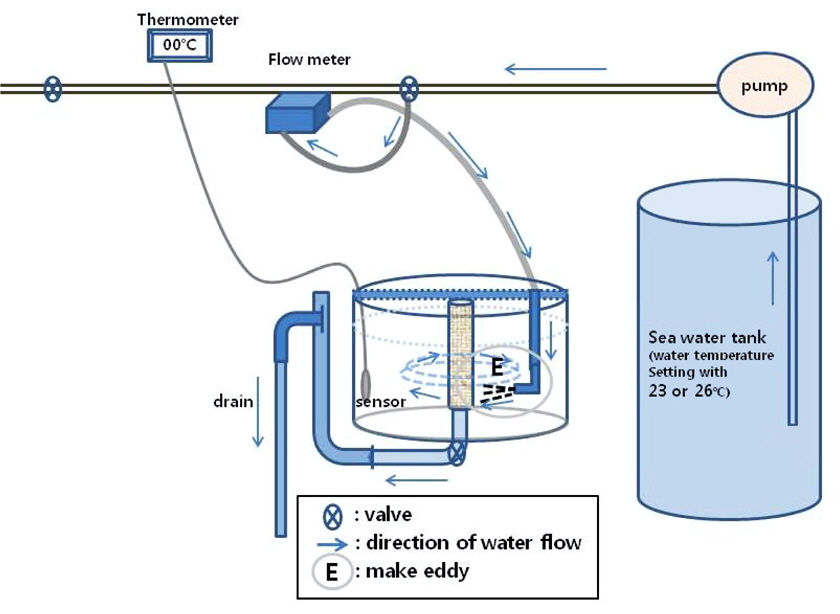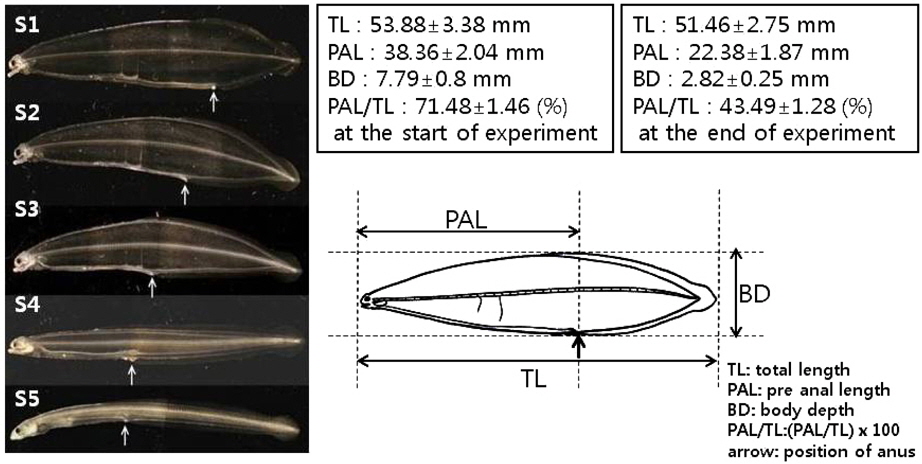



We determined the effects of starvation, water temperature, and water flow on the onset of metamorphosis in leptocephali of the Japanese eel
극동산 뱀장어(
국내에서도 극동산 뱀장어의 인공종묘 생산에 관한 연구가 시작되어(Kim et al., 2006a; 2006b; 2007a; 2007b), 2012년 인공 성성숙 유도에 의해 생산된 수정란에서 렙토세팔루스 유생을 생산하여 변태 과정을 걸쳐 인공 실뱀장어 생산에 성공하였다(Kim et al., 2013). 극동산 뱀장어는 자어를 인공적으로 사육하였을 경우 변태기까지 도달하는데 대부분 200일 이상 소요되며, 15-20일간의 변태기를 지나 인공 실뱀장어로 변태 완료한다고 보고하였다(Tanaka et al., 2003; Kim et al., 2013). 극동산 뱀장어(
본 연구는 절식과 유속이 뱀장어 자어의 변태와 관련이 있을것으로 보고 수온의 변화와 함께 자어의 변태에 미치는 영향을 조사하고자 하였다.
인공수정 및 부화 자어 생산은 Kim et al. (2007b)의 방법에 따라 이루어졌으며, 자어는 Tanaka et al. (2001)에 의해 개발된 상어알 기반의 액상사료를 변형한 개량 액상사료를 공급하여 사육하였다. 사육 수온 및 유량은 Tanaka et al. (2001)과 Masuda et al. (2011)의 방법에 따라 23℃, 0.6 L/min을 유지하면서 유수식으로 사육하였다. 부화 후 200 일경 최소 전장 50 mm 이상의 개체를 선별하여 본 실험에 사용하였다(Okamura et al., 2012).
Fig. 1에서 보여주는 실험용 사육수조에 자어를 수용 후 조건에 따른 실험을 실시하였으며, 실험용 사육수조는 10 L 용량의 아크릴 원형수조로 수온조절 탱크에서 공급되는 일정수온의 사육수가 유량계(TVI-108, NIPPON FLOW CELL, 일본)를 통과하여 아크릴 원형수조로 공급되며, 실험용 수조 내 온도감지기(GRT 356E, GILTRON, 중국)를 설치하여 수온을 상시 관찰하도록 하였다. 수조로 유입된 사육수는 일정 방향을 따라 회전하면서 유량 변화에 따라 원형수조 내에서 와류(Eddy)를 형성하도록 만들어졌다.
변태기 자어의 형태학적 변화는 Fig. 2에 나타낸 것처럼 Kuroki Kuroki et al. (2010)과 Okamura et al. (2012)의 방법에 따라 체폭의 변화, 항문위치의 이동을 근거로 판단하였으며 변태의 시작부터 끝까지를 S1~S5 단계로 나타내었다. 변태에 소요되는 시간과 실험구별 변태율을 조사하기 위해 수용일로부터 30 일간 조사하였다.
절식에 의한 변태유도 효과
절식에 따른 변태유도 효과를 조사하기 위하여 동일한 2 개의 10 L 아크릴 원형수조에 자어 6 마리씩 수용한 후, 수온 23℃, 유량 0.6 L/min로 하였다. 절식수조는 실험개시부터 사료 공급을 중지하고 변태과정을 관찰하였고, 사료 공급수조는 상어알기반의 액상사료를 1일 5회(5 mL/회) 공급하면서 관찰하였다.
수온 상승에 의한 변태유도 효과
수온 상승에 따른 변태유도 효과를 조사하기 위하여 유량은 0.6 L/min로 설정하였고, 23℃ 와 23℃에서 26℃로 수온을 상승시켜 설정된 두 사육수조에 각 3 마리씩 수용하였다. 실험기간 중 액상사료는 공급하지 않았다. 이 후 동일한 방법으로 3 마리씩 수용하여 반복실험을 실시하였다.
유량(유속) 상승에 의한 변태유도 효과
유량 상승에 따른 변태유도 효과를 조사하기 위하여, 수온은 23℃로 설정하고 유량을 0.6 L/min와 1.2 L/min 로 다르게 설정된 사육수조에 각 3 마리씩 수용하였다. 실험기간 중 액상사료는 공급하지 않았다. 이 후 동일한 방법으로 3 마리씩 수용하여 반복실험을 실시하였다.
유량(유속) 과 수온상승에 의한 변태유도 효과
일반 유량보다 빠른 1.2 L/min로 설정하고 수온은 26℃로 설정된 사육수조에 자어를 4 마리 수용하고 실험기간 중 액상배합사료는 공급하지 않았다. 이 후 동일한 방법으로 7 마리를 수용하여 반복실험을 실시하였다.
극동산 뱀장어 렙토세팔루스의 체폭 및 항문 위치의 변화를 근거로 변태의 시작부터 끝까지를 S1~S5 단계로 분류하였다. S1 단계는 완전히 자란 렙토세팔루스, S2 단계는 렙토세팔루스의 등이 약간 휘어지고 항문이 전방으로 이동, S3 단계의 렙토세팔루스 체폭은 약 25 % 정도 감소하며 항문은 거의 중앙 부위에 위치, S4 단계의 렙토세팔루스 체폭은 약 50 % 정도 감소하며 항문은 중앙 부위에서 보다 전방에 위치, S5 단계의 렙토세팔루스 체폭은 약 70 % 정도 감소하여 원통형 몸체로 형성되고, 항문 위치는 S4 단계의 개체와 비슷하였다(Fig. 2).
절식 실험구에서는 8일째부터 실뱀장어로 변태 완료한 개체가 나타나기 시작하였으며, 실험 개시 20일 동안 6마리 중 5마리가 변태 완료하였고, 1마리는 사육 중 폐사하여 변태율은 83.3%였다. 사료 공급구에서는 11-30일 사이 6마리 중 2마리만 변태를 완료하여 33.3%의 변태율을 나타내었으며, 실험기간 중 변태가 완료되지 않은 4 마리는 Fig. 2의 S1, S2 단계의 개체가 각 3마리와 1마리가 존재하였다(Table 1).

Metamophosing rate of Anguilla japonica leptocephlai in different food regimes under the water temperature of 23 ℃ and the water flow of 0.6 L/min
유량 0.6 L/min로 조정된 사육 수조에 사육 수온을 23℃ 와 26℃로 상승시킨 두 실험군에서 변태 유도 효과를 Table 2에 나타내었다. 23℃ 사육 수조의 1차 실험 결과 3마리 모두 실험기간중 변태가 완료되지 않았으며 Fig. 2의 S1, S2 단계의 개체가 각 2 마리와 1마리가 존재하였다. 2차 실험 결과에서는 3마리 중 3마리 모두 8-12일 사이에 변태를 완료하여 100% 변태율을 보였다.

Metamorphosing rate of fasted Anguilla japonica leptocephali in water temperature of 23 and 26℃ under the water flow of 0.6 L/ min
26℃ 사육 수조의 1차 실험결과 3마리 중 2마리가 7-10일 사이에 변태 완료하여 66.7% 변태율을 나타내었고 나머지 1마리는 S3 단계까지 변태하였다. 2차 실험 결과에서는 3마리 중 1마리가 8일째 변태 완료하여 33.3%의 변태율을 나타내었고 나머지 2마리는 실험 기간중 변태가 진행되지 않았으며 Fig 2의 S1, S3 단계의 개체가 각 1마리씩 존재하였다.
사육수온 23℃로 조정된 사육 수조에 유량 0.6 L/min 와 1.2 L/min 로 다른 사육조건에서 변태유도 효과를 조사한 결과를 Table 3에 나타내었다. 유량 0.6 L/min 실험구에서는 1차, 2차실험 결과 모두 3마리 중 1마리만 각 15일째와 8일째 변태하여 33.3%의 변태율을 나타냈다. 그러나 1차, 2차 실험 결과의 실험 기간중 변태가 완료되지 않은 각2마리는 Fig. 2의 S1, S2 단계의 개체가 각 2마리씩 존재하여, 평균 변태율은 33.3% 였다.

Metamorphosing rate of fasted Anguilla japonica leptocephali in water flow of 0.6 and 1.2 L/min under the water temperature of 23℃
한편 유량 1.2 L/min 실험구에서는 1차 실험 결과 14 일째, 2차 실험에서는 12-22일 사이에 각 3마리 중 2마리씩 변태를 완료하여 66.7%의 변태율은 나타내었다. 그러나 1차, 2차 실험 결과의 실험 기간중 변태가 완료되지 않은 각1마리는 Fig. 2의 S2, S3 단계의 개체가 각 1마리씩 존재하여, 평균 변태율은 66.7% 였다.
유량 1.2 L/min로 설정한 실험구에 수온 26℃로 상승시켜 변태유도 효과를 조사한 결과를 Table 4에 나타내었다. 1차 실험결과 10-12일 사이에 4마리 모두 변태 완료하여100% 변태율을 나타내었다. 2차 실험 결과에서는 7마리 중 5마리가 8~11일 사이에 변태 완료하였고, 실험 기간 중 변태가 완료되지 않은 2마리는 Fig. 2의 S2, S3 단계의 개체가 각 1마리씩 존재하여 변태율은 71.4% 였다. 따라서 1, 2 차 실험 결과의 평균 변태율은 85.7% 였다.

Metamorphosing rate of fasted Anguilla japonica leptocephali under the water flow of 1.2 L/min and water temperature of 26℃
자연에서 극동산 뱀장어의 렙토세팔루스는 이석 일령 분석을 통해 부화 후 110-170 일 정도에 변태가 이루어진다고 보고되었으며(Tabeta et al., 1987; Kawakami et al., 1998), 인공 부화자어의 경우, 부화 후 200 일 이후로 변태가 유도되는 것으로 알려져 있으나 모든 개체가 그런 것이 아니라 부화 후 2 년이 넘어도 변태하지 않는 경우도 보고되었다(Masuda et al., 2011; 2012). 또한 변태와 관련하여 변태 전 체장 성장은 인공배합사료에 의한 영양 부족이 원인으로 추정되며, 변태 개시 시점은 체장 성장이 어느 정도(50 mm 이상) 이루어진 후 환경적 요인이 작용할 것으로 생각되었다. 자연환경에서 뱀장어류의 변태를 유발시키는 요인은 아직 밝혀져 있지는 않았지만(Pfeiler, 1999; Otake, 2003; Miller, 2009), 실험실에서 절식, 체장, 수온등에 대한 영향이 보고되었다(Okamura et al., 2012).
뱀장어 자어는 변태가 시작되면 급이 활동이 멈추며(Pfeiler, 1999), 변태 전 절식시킨 그룹이 시키지 않은 그룹에 비해 변태율이 높은 것이 실험적으로 확인되었다(Okamura et al., 2012). 본 실험 결과에서도 절식구가 사료급여구에 비하여 변태율이 2배 높았으며 변태소요일도 사료급여구에 비해 조금 빠르게 나타났다.
수온은 뱀장어과 어류 자어의 성장과 변태에 중요한 요인으로 보고되었다(Arai et al., 2001). 극동산 뱀장어의 자어를 15, 20, 25 그리고 30℃의 네 실험구를 사육하여 비교하였을 때, 25℃에서 변태율이 가장 높았고 다음이 30℃였다(Kuroki et al., 2010). 그러나 본 실험결과에서는 23℃와 26℃에서 변태율의 유의성을 확인 할 수 없었다. 3℃의 수온차이는 결과의 유의적인 차이를 확인하기는 어려움이 있었던 것으로 생각된다. 단, 변태소요일은 23℃보다 26℃가 짧은 경향을 나타내어, 높은 수온이 변태속도를 높이는 이전의 보고 즉, 붕장어를 대상으로 조사한 결과에서 낮은 수온보다는 높은 수온에서 변태가 빠르다는 것을 설명하면서 변태에는 적어도 10℃ 이상의 수온이 필요하며 10℃ 이상에서도 수온이 높을수록 변태속도가 증가하는 것을 확인한(Watanabe et al., 2004) 결과와 일치한다 할수 있다 (Table 2, 4).
유속을 달리하여 변태진행을 관찰한 결과, 수온과 상관없이 0.6 L/min보다는 1.2 L/min의 유속에서 변태율이 높았으며, 변태에 소요되는 시간은 차이가 크지 않았다(Table 2). 아직 인공자어의 대량생산에는 한계가 있어 통계적으로 유의한 결과를 도출할 수 있는 충분한 수의 50 mm 이상의 자어를 시료로 사용할 수 없었던 아쉬움이 있었다.
뱀장어 자어의 변태와 관련하여 양서류의 올챙이에서 성체로의 형태변화와 유사한 진골어류, 특히 뱀장어류나 넙치류의 자어시기 형태변화를 일컫는 일차변태(true metamorphosis=first metamorphosis)에서의 갑상선호르몬(Thyroid hormoe)의 변화에 관심을 가지고 설명하고 있다(Yamano et al., 1991; Rousseau and Dufour, 2012). 이러한 자어의 생리학적 변화는 환경적인 요소의 자극으로 인해 발현될 가능성이 크다. 따라서 이러한 변태시기의 자어가 분포하는 지역 해저의 화학적 구성, 수심, 염분농도 등을 지목하였으며(Miller, 2009), 변태중인 열대 붕장어(
뱀장어 자어의 형태적 변화 경향은 자연상태에서나 인공사육에서 크게 다르지 않다고 여겨지며(Mochioka, 2003), 뱀장어 자어의 인공 생산을 산업화 하기 위해서는 자어의 변태를 유도하기에 좋은 조건을 알아내고, 그 조건을 사육시설에 적용시키는 노력이 계속적으로 이루어져야 할 것이다. 이와 더불어 친어, 자어, 치어의 자연스러운 순환사육을 위한 연구가 더욱 섬세하게 진행되어야 할 것으로 보인다.






